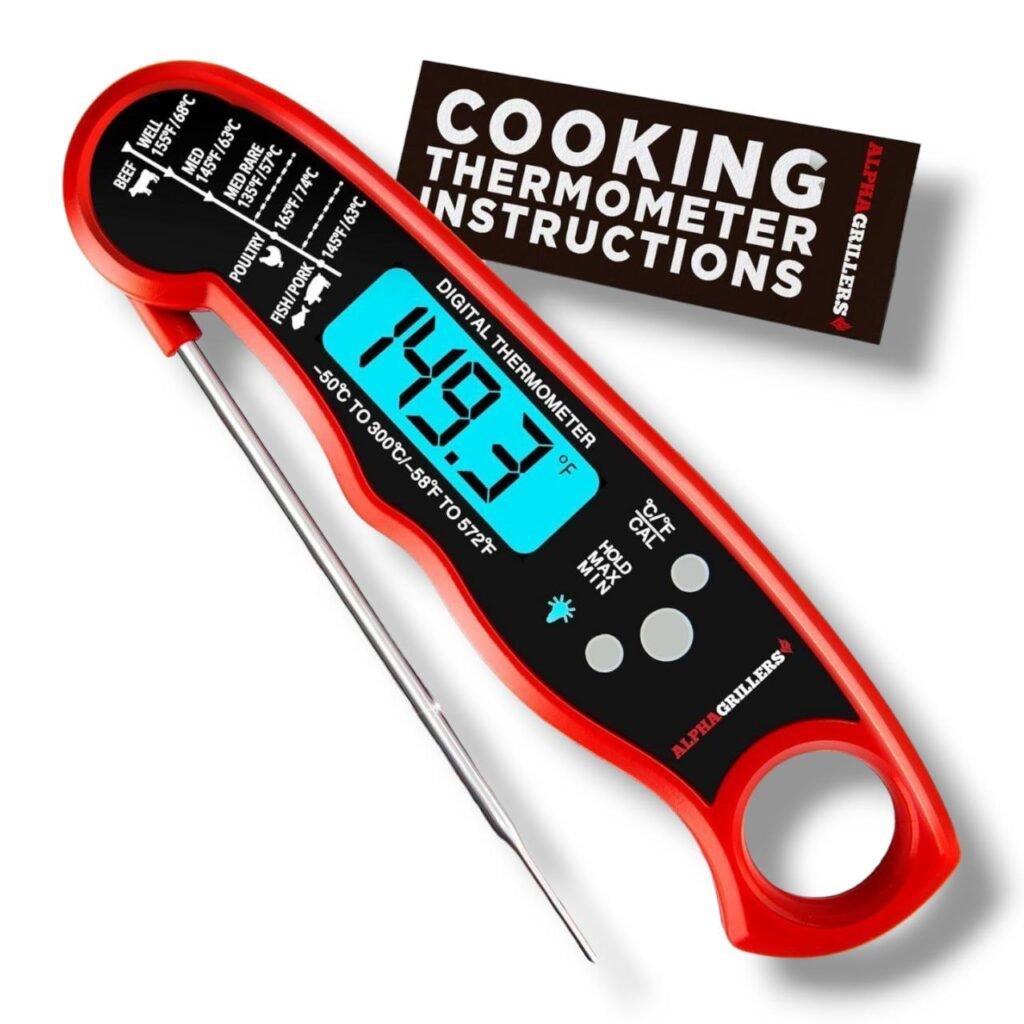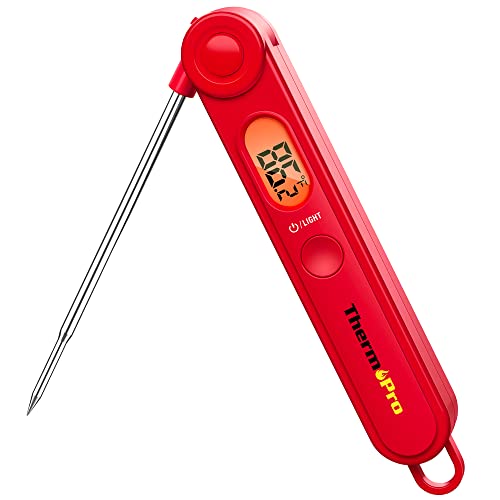
The Real Deal on Digital Meat Thermometers: No More Kitchen Panic!
Master perfect cooking with the right digital meat thermometer—ensure precise temperatures, boost food safety, and achieve consistently delicious results whether you’re grilling, roasting, or baking.
Your Kitchen’s Best Friend (Seriously!)
Okay, let’s be real here – a digital meat thermometer isn’t just another gadget collecting dust in your drawer. This little genius is what separates the “is this chicken cooked?” panic attacks from actually knowing what you’re doing in the kitchen.
- Instant Read Food Thermometer | Our instant read thermometer features a temperature probe and advanced, highly accurate …
- Multi-Use | From bbq thermometer to baking thermometer, our digital food thermometer for cooking is perfect for meats, l…
- Easy-Read Digital Thermometer For Cooking | Large instant thermometer dial with bright blue backlight means you can alwa…
You know that heart-stopping moment when you’re cutting into chicken and wondering if you’re about to poison everyone? Yeah, we’ve all been there. Most of us end up cooking the life out of everything just to be safe, which honestly makes for some pretty sad, dry meat.
Here’s the thing – a good digital meat thermometer completely eliminates that drama. No more guessing games, no more overcooked disasters, just perfectly cooked food every single time.
I’m gonna walk you through everything you need to know about these game-changers, from basic models to fancy wireless digital meat thermometers, plus where to grab a decent meat thermometer in NZ without breaking the bank.
Why You Actually Need One of These Things
Don’t Get Everyone Sick (Obviously)
Look, food poisoning is nobody’s friend. Undercooked chicken, pork, or ground meat can seriously mess you up with nasty stuff like salmonella and E. coli. Sure, you might think that slightly pink chicken looks “done enough,” but your gut (literally) might disagree later.
Here’s what I learned the hard way – you can’t always trust what things look like. That “clear juice” test everyone talks about? Sometimes it lies. Internal temperature doesn’t lie though, and that’s exactly what the pros rely on.
Pro tip: Most germs hang out on the surface of meat, so washing your hands and not cross-contaminating stuff is just as important as hitting the right temps.
Make Food That Actually Tastes Good
Beyond not poisoning people (which is nice), these thermometers help you cook stuff that’s actually delicious. Think perfectly pink medium-rare steak or chicken that’s juicy instead of resembling cardboard.
And if you’re into baking? Game changer. Making caramel or tempering chocolate becomes way less stressful when you know exactly what temperature you’re hitting.
- 【Easy to Use】Easily release the meat probe at the push of a button, and control the backlight or power with another butt…
- 【More Accurate Readout in Seconds】Get accurate temperature readings with an impressive +/-0.9°F precision, this cooking …
- 【Easy to Read】The large, easy-to-read numbers and bright backlit display make this grill thermometer simple to check you…
They’re Not Just for Meat!
Plot twist – these aren’t just meat thermometers. I use mine for:
- Checking if bread is done inside
- Getting oil to the perfect frying temp
- Making sure soups are hot enough
- Even checking my coffee temperature (don’t judge me)
Honestly, once you start using one, you’ll find excuses to temp-check everything.
What Kind Should You Get?
The Quick-Check Heroes (Instant-Read)
These are the MVPs – just stick ’em in your food and boom, temperature in like 2-5 seconds. Super easy to use and they work for pretty much everything.
Why they’re awesome:
- Crazy fast (some give readings in under a second!)
- Pretty darn accurate
- Easy to read, even in dim lighting
- Work for meat, liquids, baked goods – you name it
My top picks:
- Thermapen ONE: This thing is like the iPhone of thermometers. Stupid fast, waterproof, and built like a tank. Yeah, it’s pricey, but if you cook a lot, it’s worth it.
- ThermoPro TP19: Great value pick. Does everything the expensive ones do but won’t make your wallet cry.
- Lavatools Javelin PRO Duo: Perfect middle ground with some cool smart features.
Wireless Digital Meat Thermometers (For the Lazy Cook)
These are brilliant if you’re doing long cooks or just can’t be bothered babysitting your food. They connect to your phone and basically text you when your roast is ready.
Why you’ll love them:
- No more opening the oven every five minutes
- Set alerts so you don’t forget and burn stuff
- Some can monitor multiple things at once
- Perfect for BBQ, roasts, or anything that takes forever
Worth checking out:
- MEATER Plus: Completely wire-free and has ridiculous range
- ThermoPro TP25: Can handle four different things at once (great for big dinners)
- Weber iGrill 3: If you’ve got a Weber grill, this thing’s perfect
The Leave-It-In Types
These stay in your food the whole time it’s cooking. Great for big roasts where you want constant monitoring without the hassle.
Calibratable Digital Thermometers (For the Perfectionists)
If you’re really serious about accuracy, these let you fine-tune the readings. Honestly, most home cooks don’t need this, but if you’re a control freak (in the best way), go for it.
Quick calibration check: Stick it in ice water – should read 0°C. Boiling water should hit 100°C (unless you’re up a mountain or something).
How to Actually Use the Thing
Where to Stick It (The Probe, Obviously)
This is super important – shove that probe into the thickest part of whatever you’re cooking. Avoid bones, fat, or gristle because they’ll mess with your reading. For thin stuff, go in from the side.
When to Check
Don’t wait until you think it’s done – check a bit before that. For big chunks of meat, test a few spots to make sure everything’s cooking evenly.
Let It Rest (Your Meat, Not You)
Here’s a neat trick the pros use – pull your meat off the heat about 5-10 degrees before your target temp. Cover it with foil and let it sit for 10-15 minutes. The temperature keeps rising while the juices settle, giving you way better results.
Keep It Clean
Wash that probe before and after every use. Nobody wants yesterday’s chicken contaminating today’s steak. And for the love of all that’s holy, don’t leave it in the dishwasher – hand wash only!
The Magic Numbers (AKA Don’t Die)
Chicken and Friends
- Chicken & Turkey: 74°C (165°F) – no pink bits, clear juices
- Duck: Same deal, 74°C
Beef and Lamb (The Fun Stuff)
- Rare: 54-57°C – still mooing (kidding!)
- Medium-rare: 57-60°C – perfect pink center
- Medium: 60-66°C – slightly pink
- Well-done: 71°C+ – if you must…
Pork
- Pork chops/roasts: 63°C – can be slightly pink now (they changed the rules!)
- Ground pork: 71°C – play it safe
Ground Meat (All of It)
- Everything ground: 71-74°C – because grinding mixes all the surface bacteria throughout
Fish
- Most fish: 63°C – should flake easily and look opaque
Stop Stressing About Cooking
Your New Confidence Booster
Honestly, once you start using a thermometer, cooking becomes so much less stressful. No more anxiety attacks about whether the chicken’s done – you just know.
Try Some Foolproof Methods
If you’re still nervous, try slow cooking methods like braising or using a slow cooker. These are pretty much impossible to mess up and keep everything at safe temps.
Sous vide is another cheat code – you literally can’t overcook anything because it never gets hotter than your target temperature.
Trust the Process
With practice, you’ll start recognizing visual cues too. But until then, your thermometer’s got your back.
Shopping Guide (Because Choices Are Overwhelming)
Speed Matters
Look for something that gives readings in under 3 seconds. Nobody wants to stand there with the oven door open forever.
Features That Actually Matter
- Backlit screen – for when you’re cooking in mood lighting
- Auto-shutoff – saves your batteries
- Magnetic back – stick it on your fridge or grill
- Waterproof – for easy cleaning
- Alarms – if you’re going wireless
Budget Reality Check
- Cheap and cheerful ($15-30): ThermoPro TP03A works just fine
- Sweet spot ($30-60): ThermoPro TP19 or Lavatools Javelin
- Go all out ($60-100+): Thermapen or ThermoWorks – these are basically kitchen jewelry
Finding One in New Zealand
Online Options
- Amazon Australia ships here (just factor in shipping)
- The Warehouse has decent basic models
- Mitre 10 for the BBQ enthusiasts
- Briscoes often has sales
Physical Stores
- Farmers stores
- Kitchen specialty shops (they’ll have the good stuff)
- BBQ stores
- Even some department stores
NZ tip: Check warranty coverage if you’re buying international. Local stores might cost a bit more, but you’ll get better support if something goes wrong.
Pro Tips From Someone Who’s Made Mistakes
Multiple Probes = Multiple Wins
If you’re cooking for a crowd, get a multi-probe wireless system. You can monitor the turkey, ham, and roast beef all at once without running around like a headless chicken.
Keep Notes
I know, I know – who keeps cooking notes? But seriously, jot down what temps worked for different cuts. You’ll thank yourself later.
Don’t Be Dumb Like I Was
Never leave the probe in food when you’re storing leftovers. Clean it right away and store it safely. And replace the batteries before they die mid-cook (learned this one the hard way during Christmas dinner).
Getting Fancy
Reverse Searing
This is a cool technique – cook low and slow until you hit your target temp, then blast it with high heat for a killer crust. Your thermometer makes this foolproof.
Candy Making
If you’re into making sweets, these thermometers are essential. Different candy stages need exact temps, and guessing just doesn’t work.
Bread Baking
Internal temp tells you when bread is perfectly done inside:
- Regular bread: 88-96°C
- Rich breads: 85-88°C
When Things Go Wrong
Wonky Readings?
Could be a few things:
- Probe’s touching bone or fat (move it)
- Battery’s dying (swap it out)
- Probe’s damaged (time for a new one)
- Extreme temp changes (give it a minute to adjust)
Calibration Drift
Even good thermometers can get a bit off over time. Test it occasionally in ice water – should read 0°C. If it’s consistently off, either calibrate it (if possible) or replace it.
Bottom Line
Look, a digital meat thermometer turns cooking from a stressful guessing game into something you actually enjoy. Whether you go basic or splurge on a fancy wireless digital meat thermometer, you’re investing in better food and way less kitchen anxiety.
Stop overcooking everything out of fear! With the right thermometer and a bit of practice, you’ll be turning out restaurant-quality food at home. Your friends will think you’re some kind of cooking genius (and you don’t have to tell them it’s just because you finally know the actual temperature of things).
For my fellow Kiwis, there are plenty of good meat thermometer NZ options both online and in stores. Don’t overthink it – even a basic model will change your cooking game completely.
Quick Answers to Questions You’re Probably Asking
Q: How much should I actually spend? A: Honestly? $20-40 gets you something perfectly good for home cooking. If you cook a lot or want all the bells and whistles, $60-100 is worth it. Don’t go crazy unless you’re opening a restaurant.
Q: Do I really need the wireless ones? A: They’re awesome for long cooks, smoking, or if you want to chill on the couch while your roast does its thing. For quick everyday cooking, instant-read is usually enough.
Q: How often do I need to calibrate this thing? A: Maybe once a month if you use it heaps, or just before big cooking sessions. Most people never bother and do just fine.
Q: Can I leave it in the oven? A: Only if it specifically says “oven-safe” with the heat-resistant cable. Regular instant-read ones are just for quick checks.
Q: What’s the most important thing to look for? A: Accuracy first, speed second. A slow but accurate thermometer is way better than a fast but wrong one!.


